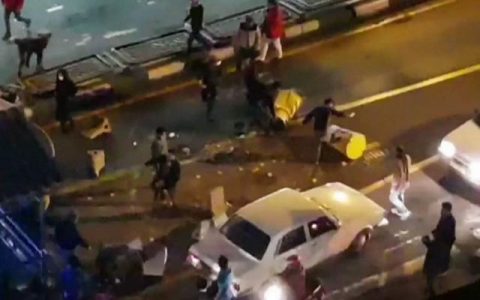
Defiant Iran protesters steal Revolutionary Guard’s trousers even as death toll mounts
The Basij militiaman, a paramilitary storm trooper of Iran’s Revolutionary Guard, was reportedly swinging an electric shock baton when the crowd of angry protesters closed in around him.
“They got a Basij, hold him!” one man shouted as the demonstrators pulled away the militiaman’s baton and knocked him to the ground in the largely Kurdish city of Kermanshah.
But rather than beat the man to death, the crowd struck a different kind of blow against Iran’s authoritarian regime: they stripped him of his trousers and sent him stumbling and humiliated into the cold night.
“The protesters wanted to show that they are peaceful but that they are not weak and they are not afraid,” said Raman Ghavami, an Iranian analyst who has been tracking the protest.
In Kermanshah and in cities and towns across Iran, emboldened and defiant protesters continued the largest demonstrations since 2009 even as security forces stepped up the violence to try to suppress them.
At least 10 people were killed across the country on Sunday night, according to state television, but opposition activists said the real death toll was likely higher.
Six people were reportedly killed after security forces opened fire in the western town Tuyserkan and another two were shot dead in the southwestern town of Izeh.
Two people, including a teenage boy, were killed after being run over by a fire engine stolen by protesters in the town of Dorud, state media said. Two other people were shot dead on Saturday in Dorud, which has been a flashpoint for protests.
Iran’s government claimed that armed demonstrators had tried to seize control of police stations and military bases. There was no independent confirmation of the claim but videos on social media purported to show a group of men ransacking a Revolutionary Guard office and pulling down a picture of the Ayatollah Khomeini, the founder of the Islamic Republic.
The protests began on Thursday as a narrow demonstration over rising food prices but quickly spiraled into into the gravest challenge to the Iran’s theocratic government since 2009, when millions of people took to the streets to protest against disputed election results.
The unrest appears decentralised and leaderless, with different groups taking to the streets over different issues but all united in their anger with the government.

Hassan Rouhani, Iran’s president, who was re-elected on a reformist platform earlier this year, has tried to strike a balance between acknowledging some of the protesters’ grievances while also warning that the government would crack down.
The protests “may seem to be a threat, but it can be turned into an opportunity to see what the problem is,” Mr Rouhani said Monday. “One of the demands of the people is for us to give them more freedom.”
The sudden demonstrations have scrambled Iran’s politics. While Mr Rouhani’s hardliner opponents initially appeared encouraged by the discontent with his economic policies, they were caught off guard as the unrest took aim at the core pillars of the Islamic Republic, including the supreme leader Ayatollah Khamenei.
Donald Trump, the US president, said “Iran is failing at every level” and it was “time for change”. “The great Iranian people have been repressed for many years. They are hungry for food and for freedom,” he tweeted.
Opposition activists criticised European governments and especially Federica Mogherini, the EU foreign policy chief, for not speaking out against Iran’s crackdown on dissent.
“We haven’t heard anything from Mogherini. She is a close, personal friend of [Iranian foreign minister] Zarif and never misses a chance to meet him,” said Ali Reza, an Iranian dissident in exile. “People are really dissatisfied about this.”
Boris Johnson, the foreign secretary, said he was “watching events in Iran with concern”.
While the unrest has spread across Iran, including the capital Tehran, many of the most serious clashes have been in the west of the country, where minority groups like Kurds, Arabs and Azaris have gave given voice to their feelings of marginalisation by Iran’s largely Persian government.
Unverified videos on social media purported to show Iranian military vehicles deploying to the west of the country in response to the demonstrations.






